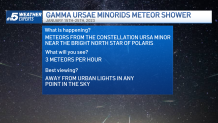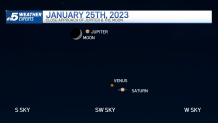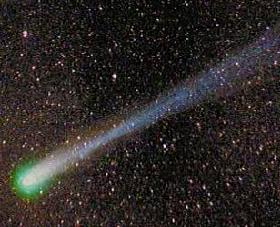January Astronomy: What Is Happening This Month in the North Texas Sky? – NBC 5 Dallas-Fort Worth
INTERNATIONAL STATION FLY-BYS
The International Space Station will make numerous flybys across the North Texas sky this month. The ISS will appear as a fast-moving star across the night sky.

The International Space Station rotates around the Earth at a speed of 17,500 mph. The ISS rotates about its center of mass at a rate of about 4 degrees per minute so that it will complete a full rotation once per orbit. This allows it to keep its belly towards the Earth. One revolution around the planet takes about 90 minutes (16 per day).
Also, the International Space Station lies at an altitude of 250 miles above the Earth. By the way, that is 1.32 million feet. Most commercial airplanes fly between 33,000 to 42,000 feet.
A METEOR SHOWER
The Gamma Ursae Minorids Meteor Shower will take place in mid-January with a peak on January 19th.

This meteor shower originates from the constellation Ursa Minor, near the bright north star Polaris. During the nighttime hours, three meteors can be seen every hour.
MERCURY MAKES ITS HIGHEST PEAK
Mercury, the planet closest to the Sun, will make its highest peak in the morning sky by month’s end.

On Jan. 23 before sunrise, the planet reaches its morning peak 13 degrees above the southwestern horizon. It will actually sit this high above the horizon for several mornings on either side of the 23rd (the 18th-30th).
Mercury averages a distance from the Earth at 48 million miles and from the Sun at 36 million miles.
WATCHING THE MOON, JUPITER, VENUS AND SATURN
We’re saying hello to a January conjunction: the meeting of the moon and Jupiter on Jan. 25. After sunset, you’ll see a waxing crescent moon travel just beneath Jupiter.

Also, on Jan. 22, Venus and Saturn will appear less than half of a degree apart in the night sky.
Venus’s distance from the Earth varies from 24 million miles to 162 million miles. Jupiter’s distance from the Earth varies from 336 million miles to 600 million miles. Saturn’s distance from the Earth varies from 746 million miles to 1 billion miles.
A GREEN COMET FLY-BY
A green comet discovered in March 2022 will make its closest approach to Earth by month’s end.
The comet C/2022 E3 (ZTF) was first discovered by astronomers at California’s Zwicky Transient Facility when it was passing Jupiter. The comet will become more visible as it moves closer to the planet.

The comet will make its closest approach on Feb 1. Until then, you can find the comet in the morning sky as it moves toward the northwest.
The last time this comet passed close to the Earth was 50,000 years ago, that is when Neanderthals roamed the planet.
Please enjoy these events happening in the night sky this month. Until then…Texans, keep looking up!





